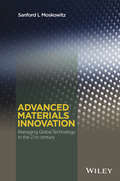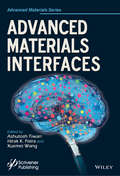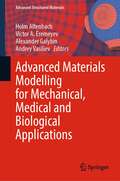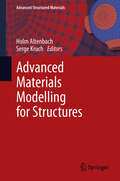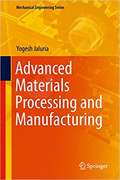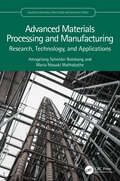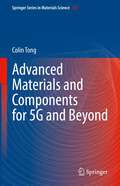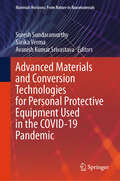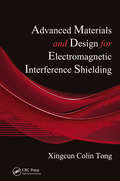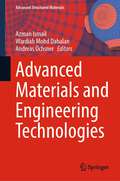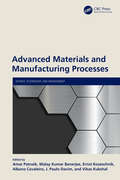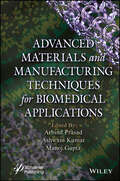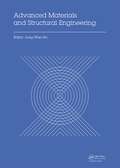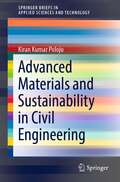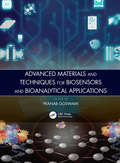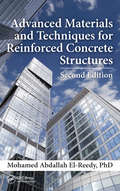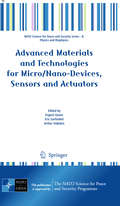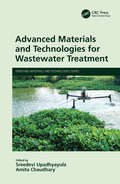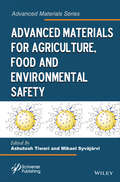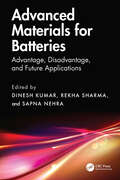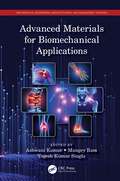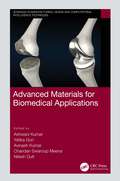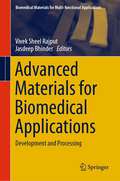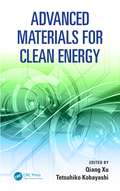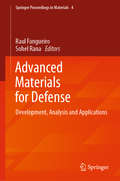- Table View
- List View
Advanced Materials Innovation: Managing Global Technology in the 21st century
by Sanford L. MoskowitzThrough detailed case studies of the most important advanced material creations of the latter 20th and early 21st century, the author explores the role of the field of advanced materials in the technological and economic activity today, with implications to the innovation process in general. A comprehensive study that encompasses the three major categories of advanced material technologies, i.e., Structural Materials (metals and polymers), Functional Materials (transistor, microchip and semiconductor laser) and Hybrid and New Forms of Matter (liquid crystals and nanomaterials). Extensive use of primary sources, including unpublished interviews with the scientists, engineers, and entrepreneurs on the front lines of advanced materials creation Original approach to case study narrative, emphasizing interaction between the advanced material process, perceived risk and directing and accelerating breakthrough technology
Advanced Materials Interfaces
by Ashutosh Tiwari Hirak K. Patra Xuemei WangAdvanced Material Interfaces is a state-of-the-art look at innovative methodologies and strategies adopted for interfaces and their applications. The 13 chapters are written by eminent researchers not only elaborate complex interfaces fashioned of solids, liquids, and gases, but also ensures cross-disciplinary mixture and blends of physics, chemistry, materials science, engineering and life sciences. Advanced interfaces operate fundamental roles in essentially all integrated devices. It is therefore of the utmost urgency to focus on how newly-discovered fundamental constituents and interfacial progressions can be materialized and used for precise purposes. Interfaces are associated in wide multiplicity of application spectrum from chemical catalysis to drug functions and the advancement is funnelled by fine-tuning of our fundamental understanding of the interface effects.
Advanced Materials Modelling for Mechanical, Medical and Biological Applications (Advanced Structured Materials #155)
by Holm Altenbach Victor A. Eremeyev Alexander Galybin Andrey VasilievThe book is devoted to the 70th birthday of Prof. Sergey M. Aizikovich, which will celebrated on August 2nd 2021. His scientific interests are related to the following topics: Mechanics of contact interactions, Functionally graded materials, Mechanics of fracture, Integral equations of mathematical physics, Inverse problems of the theory of elasticity, and Applications of elasticity to biological and medical problems of mechanics of materials. The papers, collected in the book, are contributions of authors from 10 countries.
Advanced Materials Modelling for Structures: With Multi-scale Effects Or Under Multi-field Actions (Advanced Structured Materials #19)
by Holm Altenbach Serge KruchThis volume presents the major outcome of the IUTAM symposium on "Advanced Materials Modeling for Structures". It discusses advances in high temperature materials research, and also to provides a discussion the new horizon of this fundamental field of applied mechanics. The topics cover a large domain of research but place a particular emphasis on multiscale approaches at several length scales applied to non linear and heterogeneous materials. Discussions of new approaches are emphasised from various related disciplines, including metal physics, micromechanics, mathematical and computational mechanics.
Advanced Materials Processing and Manufacturing (Mechanical Engineering)
by Yogesh JaluriaFocuses on new and advanced methods of manufacturing and materials processing with traditional methods described in light of the new approaches.<P><P> Maximizes reader understanding of the fundamentals of how materials change, what transport processes are involved, and how these can be simulated and optimized - concepts not covered elsewhere.<P> Introduces new materials and applications in manufacturing and summarizes traditional processing methods, such as heat treatment, extrusion, casting, injection molding, and bonding, to show how they have evolved and how they could be used for meeting the challenges that we face today<P>This book focuses on advanced processing of new and emerging materials, and advanced manufacturing systems based on thermal transport and fluid flow. It examines recent areas of considerable growth in new and emerging manufacturing techniques and materials, such as fiber optics, manufacture of electronic components, polymeric and composite materials, alloys, microscale components, and new devices and applications. The book includes analysis, mathematical modeling, numerical simulation and experimental study of processes for prediction, design and optimization. It discusses the link between the characteristics of the final product and the basic transport mechanisms and provides a foundation for the study of a wide range of manufacturing processes.
Advanced Materials Processing and Manufacturing: Research, Technology, and Applications (Advanced Materials Processing and Manufacturing)
by Amogelang Sylvester Bolokang Maria Ntsoaki MathabatheThis book describes the operations and industrial processes related to the production of advanced materials including ingot and powder metallurgy processing routes. It outlines the deformation processing mechanisms inducing failure at both ambient and high temperatures. Further, it embodies practical knowledge and engineering mechanisms of traditional and unorthodox material disposal approaches, concurrently with gear cutting/ manufacturing and computer numerically controlled machining. The surface fusion of metals in the production of coatings via the process of laser cladding is also covered. Features: Covers novel and multi-variety techniques of materials processing and manufacturing. Reports on the significant variables of the processes and basic operations of advanced materials. Discusses fundamental and engineering machining analysis. Includes novel fabrication of TiAl alloys using both powder and ingot metallurgy routes. Enables critical thinking through technical problem solving of local service manufacturers. This book is aimed at researchers and graduate students in materials and manufacturing engineering.
Advanced Materials and Components for 5G and Beyond (Springer Series in Materials Science #327)
by Colin TongThis book provides a comprehensive introduction to the current status and future trends of materials and component design for fifth-generation (5G) wireless communications and beyond. Necessitated by rapidly increasing numbers of mobile devices and data volumes, and acting as a driving force for innovation in information technology, 5G networks are broadly characterized by ubiquitous connectivity, extremely low latency, and very high-speed data transfer. Such capabilities are facilitated by nanoscale and massive multi-input multi-output (MIMO) with extreme base station and device densities, as well as unprecedented numbers of antennas. This book covers semiconductor solutions for 5G electronics, design and performance enhancement for 5G antennas, high frequency PCB materials and design requirements, materials for high frequency filters, EMI shielding materials and absorbers for 5G systems, thermal management materials and components, and protective packaging and sealing materials for 5G devices. It explores fundamental physics, design, and engineering aspects, as well as the full array of state-of-the-art applications of 5G-and-beyond wireless communications. Future challenges and potential trends of 5G-and-beyond applications and related materials technologies are also addressed. Throughout this book, illustrations clarify core concepts, techniques, and processes. At the end of each chapter, references serve as a gateway to the primary literature in the field. This book is essential reading for today’s students, scientists, engineers and professionals who want to understand the current status and future trends in materials advancement and component design in 5G and beyond, and acquire skills for selecting and using materials and 5G component design that takes economic and regulatory aspects into account.
Advanced Materials and Conversion Technologies for Personal Protective Equipment Used in the COVID-19 Pandemic (Materials Horizons: From Nature to Nanomaterials)
by Sarika Verma Avanish Kumar Srivastava Suresh SundaramurthyThis book provides an overview of the latest research on COVID-19 antiviral personal protective equipment (PPE), including safety, handling, and disposal. It also examines a range of durable, energy-efficient, and next-generation construction and building materials and energy fuel storage applications produced from PPE wastes. The topics covered include impact of PPE waste generation during COVID-19 pandemic on the environmental sustainability and its economic aspects, circular economy for advanced materials from used PPEs, conversion technologies, sustainability, reuse, and end of life materials from PPEs used in COVID-19 pandemic and microwave and plasma conversion technologies for used PPEs. The book also discusses thermo-chemical conversion technologies, various properties, and performance attributes. The book is a valuable reference for researchers and professionals in the areas of material science. It also proves as a valuable resource for policymakers and administrators involved in regulatory aspects of PPE kits.
Advanced Materials and Design for Electromagnetic Interference Shielding
by Xingcun Colin TongWith electromagnetic compliance (EMC) now a major factor in the design of all electronic products, it is crucial to understand how electromagnetic interference (EMI) shielding products are used in various industries. Focusing on the practicalities of this area, Advanced Materials and Design for Electromagnetic Interference Shielding comprehensively
Advanced Materials and Engineering Technologies (Advanced Structured Materials #162)
by Andreas Öchsner Azman Ismail Wardiah Mohd DahalanThis book reports on various real-world and global engineering problems while touching on evolving design strategies. The chapters were selected from the 2nd International Conference on Marine and Advanced Technologies 2021 (ICMAT 2021). The papers discuss best practice and theory in relation to multi-disciplinary approaches in materials engineering technology. Among the topics are advanced materials, applied science, marine engineering and energy application.
Advanced Materials and Manufacturing Processes: Proceedings Of Icadma 2020 (Science, Technology, and Management)
by J. Paulo Davim Amar Patnaik Albano Cavaleiro Ernst Kozeschnik Vikas Kukshal Malay Kumar BanerjeeThis book discusses advanced materials and manufacturing processes with insights and overviews on tribology, automation, mechanical, biomedical, and aerospace engineering, as well as the optimization of industrial applications. The book explores the different types of composite materials while reporting on the design considerations and applications of each. Offering an overview of futuristic research areas, the book examines various engineering optimization and multi-criteria decision-making techniques and introduces a specific control framework used in analyzing processes. The book includes problem analyses and solving skills and covers different types of composite materials, their design considerations, and applications. This book is an informational resource for advanced undergraduate and graduate students, researchers, scholars, and field professionals, providing an update on the current advancements in the field of manufacturing processes.
Advanced Materials and Manufacturing Techniques for Biomedical Applications (Advances In Manufacturing, Design And Computational Intelligence Techniques Ser.)
by Manoj Gupta Ashwani Kumar Arbind PrasadADVANCED MATERIALS and MANUFACTURING TECHNIQUES for BIOMEDICAL APPLICATIONS The book provides essential knowledge for the synthesis of biomedical products, development, nanomaterial properties, fabrication processes, and design techniques for different applications, as well as process design and optimization. In origin, biomaterials can come from nature or be synthesized in the laboratory with a variety of approaches that use metals, polymers, ceramic, or composite materials. They are often used or adapted for various biomedical applications. Biomaterials are commonly used in scaffolds, orthopedic, wound healing, fracture fixation, surgical sutures, artificial organ developments, pins and screws to stabilize fractures, surgical mesh, breast implants, artificial ligaments and tendons, and drug delivery systems. The sixteen chapters in Advanced Materials and Manufacturing Techniques in Biomedical Applications cover the synthesis, processing, design, manufacturing, and characterization of advanced materials; self-healing, bioinspired, nature-resourced, nanobiomaterials for biomedical applications; and manufacturing techniques such as rapid prototyping, additive manufacturing, etc. Audience The book is for engineers, technologists, and researchers working in the area of biomedical engineering and manufacturing techniques. It is also appropriate for upper-level undergraduate and graduate students.
Advanced Materials and Structural Engineering: Proceedings of the International Conference on Advanced Materials and Engineering Structural Technology (ICAMEST 2015), April 25-26, 2015, Qingdao, China
by Jong Wan HuThe ICAMEST 2015 Conference covered new developments in advanced materials and engineering structural technology. Applications in civil, mechanical, industrial and material science are covered in this book. Providing high-quality, scholarly research, addressing developments, applications and implications in the field of structural health monitoring, construction safety and management, sensors and measurements. This volume contains new models for nonlinear structural analysis and applications of modeling identification. Furthermore, advanced chemical materials are discussed with applications in mechanical and civil engineering and for the maintenance of new materials. In addition, a new system of pressure regulating and water conveyance based on small and middle hydropower stations is discussed.An experimental investigation of the ultimate strength and behavior of the three types of steel tubular K-joints was presented. Furthermore, real-time and frequency linear and nonlinear modeling performance of materials of structures contents were concluded with the notion of a fully brittle material, and this approach is implemented in the book by outlining a finite-element method for the prediction of the construction performance and cracking patterns of arbitrary structural concrete forms. This book is an ideal reference for practicing engineers in material, mechanical and civil engineering and consultants (design, construction, maintenance), and can also be used as a reference for students in mechanical and civil engineering courses.
Advanced Materials and Sustainability in Civil Engineering (SpringerBriefs in Applied Sciences and Technology)
by Kiran Kumar PolojuThis book discusses the detailed concepts of concrete and its development with pros and cons. Besides, the significance of various industrial wastes as partial replacements with concrete ingredients such as cement and aggregates are discussed. The creation of cement contributes to around 7% of carbon emissions into the atmosphere leading to greenhouse effect and global warming. Similarly, the wastes generated from various industries such as thermal, steel, ceramic, marble, paper and etc. shows the impact on atmosphere and leads to air pollution and land pollution. Thus, it is essential to focus on these wastes to use them in a profitable manner without compromising the current needs. This book discusses a few examples on studies of using various industry wastes as partial replacement of cement in concrete
Advanced Materials and Techniques for Biosensors and Bioanalytical Applications
by Pranab GoswamiBioanalytical science and its technological subdomain, biosensors, are ever-evolving subjects, striving for rapid improvement in terms of performance and expanding the target range to meet the vast societal and market demands. The key performance factors for a biosensor that drive the research are selectivity, sensitivity, response time, accuracy, and reproducibility, with additional requirements of its portability and inexpensive nature. These performance factors are largely governed by the materials and techniques being used in these bioanalytical platforms. The selection of materials to meet these requirements is critical, as their interaction or involvement with the biological recognition elements should initiate or improve these performance factors. The technique discussed primarily applies to transducers involved in converting a biochemical signal to optical or electrical signals. Over the years, the emergence of novel materials and techniques has drastically improved the performance of these bioanalytical systems, enabling them to expand their analytical horizon. These advanced materials and techniques are central to modern bioanalytical and biosensor research. Advanced Materials and Techniques for Biosensors and Bioanalytical Applications provides a comprehensive review of the subject, including a knowledge platform for both academics and researchers. Considering biosensors as a central theme to this book, an outline on this subject with background principles has been included, with a scope of extending the utility of the book to coursework in graduate and postgraduate schools. Features: • Basic principles on different classes of biosensors, recent advances and applications • Smart materials for biosensors and other rapid, portable detection devices • Metal nanoparticles and nanocrystals for analytical applications • Carbon-based nanoparticles and quantum dots for sensing applications • Nanozymes as potential catalysts for sensing applications • Bioelectrochemiluminescence and photoelectrochemical-based biosensors • Paper electronics and paper-based biosensors • Microbial biosensors: artificial intelligence, genetic engineering, and synthetic biology • Biofuel cells as a signal transduction platform • FET-based biosensors, including ISFET and BioFET This book serves as a reference for scientific investigators and a textbook for a graduate-level course in biosensors and advanced bioanalytical techniques.
Advanced Materials and Techniques for Reinforced Concrete Structures
by Mohamed Abdallah El-Reedy Ph.DIncrease the Durability and Performance of Concrete during Its LifetimeWhile reinforced concrete is a durable material used for a wide range of construction projects in civil engineering, certain factors must be considered during its design, construction, and maintenance. This includes a variety of conditions impacting strength and performance rele
Advanced Materials and Technologies for Micro/Nano-Devices, Sensors and Actuators (NATO Science for Peace and Security Series B: Physics and Biophysics)
by Arthur Dideikin Eric Garfunkel Evgeni GusevThe main goal of this book is to review recent progress and current status of MEMS/NEMS technologies and devices. Several important areas are discussed: history of research in the field, device physics, examples of sucessful applications, sensors, materials and processing aspects. The authors who have contributed to the book represent a diverse group of leading scientists from academic, industrial and governmental labs worldwide who bring a broad array of backgrounds such as device physics, technologists, electrical and mechanical engineering, surface chemistry and materials science). The contributions to this book are accessible to both expert scientists and engineers who need to keep up with leading edge research, and newcomers to the field who wish to learn more about the exciting basic and applied research issues relevant to micromechanical devices and technologies.
Advanced Materials and Technologies for Wastewater Treatment (Emerging Materials and Technologies)
by Sreedevi Upadhyayula Amita ChaudharyAdvanced Materials and Technologies for Wastewater Treatment discusses the methods and technologies of physical, chemical, biological, and thermo-catalytic treatment techniques. It includes the treatment of waste generated by municipal, agro-industry, and other industries including chemical, biomedical, pharmaceutical, textile, and other sectors. FEATURES Covers implementation of advanced water and wastewater treatment techniques, with a focus on pollutant or pathogen removal Includes qualitative and quantitative analyses Focuses on physical, chemical, and biological treatment technologies Discusses the advancements of materials and technologies applicable to both potable water and wastewater from industrial and municipal sources Explores future challenges and viable solutions This book is aimed at chemical and environmental engineers and researchers seeking a thorough treatment of innovative water treatment materials and techniques for practical applications.
Advanced Materials for Agriculture, Food and Environmental Safety (Advanced Material Series)
by Ashutosh Tiwari Mikael SyväjärviThe levels of toxic and microbial contamination in the food and environment are influenced by harvesting or slaughtering technologies and by the processes applied during food manufacture. With current cultivation methods, it is impossible to guarantee the absence of pesticides and pathogenic microorganisms in raw foods, both of plant and animal origin. Widespread and increasing incidence of foodborne diseases and the resulting social and economic impact on the world population have brought food and environmental safety to the forefront of ecological safety and public health concerns. The emerging field of advanced materials based on functional architectures offers potential solutions to some of the key performance challenges along with the improved sensitivity, longevity, stability, miniaturization and ruggedness, while reducing complexity and production cost. The overall purpose of this book is to generate new solutions to the technical challenges in easy and rapid detections of food toxicants, microorganisms and environmental pollutants. The book focuses on the role of advanced materials in the food, water and environmental applications The monitoring of harmful organisms and toxicants in water, food and beverages is mainly discussed in the respective chapters. The senior contributors write on the following topics: Layered double hydroxides and environment Corrosion resistance of aluminium alloys of silanes New generation material for the removal of arsenic from water Prediction and optimization of heavy clay products quality Enhancement of physical and mechanical properties of fiber Environment friendly acrylates latices Nanoparticles for trace analysis of toxins Recent development on gold nanomaterial as catalyst Nanosized metal oxide based adsorbents for heavy metal removal Phytosynthesized transition metal nanoparticles- novel functional agents for textiles Kinetics and equilibrium modeling Magnetic nanoparticles for heavy metal removal Potential applications of nanoparticles as antipathogens Gas barrier properties of biopolymer based nanocomposites: Application in food packing Application of zero-valent iron nanoparticles for environmental clean up Environmental application of novel TiO2 nanoparticles
Advanced Materials for Batteries: Advantage, Disadvantage, and Future Applications
by Dinesh Kumar Rekha Sharma Sapna NehraThe rise of renewable energy responds to global warming, necessitating reliable storage like batteries. Though frequent use can affect their lifespan, these have become smaller, simpler, and more adaptable. Recent technological progress has improved batteries' longevity and efficiency, with costs dropping due to mass production. This book examines different battery types, their evolution, and the cutting-edge materials enhancing their performance, particularly focusing on metal oxides in various battery technologies.Exploring advanced materials for batteries is not just a theoretical exercise but a practical journey into the future of energy. This book is an essential guide, tracing the evolution from early battery technology to the latest innovations and equipping researchers, engineers, and students with the practical knowledge to drive the next wave of sustainable energy solutions.Key Features:· Provides a comprehensive resource for academics, researchers, and engineers in energy storage, with detailed insights into various battery types.· Discusses advanced materials for smart and small batteries.· Delves into cutting-edge materials designed for compact and efficient batteries.· Offers a visionary outlook on the evolution of battery technology and traces historical advances alongside the latest breakthroughs in battery science and future perspectives.This book serves as a beacon, bridging historical milestones with future goals. It thoroughly explores materials, including lithium-ion and sodium-ion, in a manner accessible to everyone. It lays a robust groundwork for innovators in energy storage, steering us towards a more sustainable tomorrow. This work informs and connects readers to the evolving narrative of battery technology.
Advanced Materials for Biomechanical Applications (Mathematical Engineering, Manufacturing, and Management Sciences)
by Ashwani KumarThis book provides in-depth knowledge about cross rolling of biomedical alloys, cellulose, magnetic iron oxide nanoparticles, magnesium-based nanocomposites, titanium, titanium alloys, stainless steel, and improved biodegradable implants materials for biomechanical applications like joint replacements, bone plates, bone cement, artificial ligaments and tendons, dental implants for tooth fixation, and hip implants. It comprehensively covers advancements in materials including graphene-reinforced magnesium metal matrix, magnesium and its alloys, and 2D nanomaterials. The text discusses important topics including advanced materials for biomechanical applications, design, and analysis of stainless steel 316L for femur bone fracture healing, design and manufacturing of prosthetic dental implants, a biomechanical study of a low-cost prosthetic leg, and an energy harvesting mechanism for walking applications. The text will serve as a useful text for graduate students, academic researchers, and general practitioners in areas including materials science, manufacturing engineering, mechanical engineering, and biomechanical engineering.
Advanced Materials for Biomedical Applications (Advances in Manufacturing, Design and Computational Intelligence Techniques)
by Ashwani Kumar Avinash Kumar Yatika Gori Chandan Swaroop MeenaThe text discusses synthesis, processing, design, simulation and characterization of biomaterials for biomedical applications. It synergizes exploration related to various properties and functionalities in the biomedical field through extensive theoretical and experimental modeling. It further presents advanced integrated design and nonlinear simulation problems occurring in the biomedical engineering field. It will serve as an ideal reference text for senior undergraduate and graduate students, and academic researchers in fields including biomedical engineering, mechanical engineering, materials science, ergonomics, and human factors. The book Employs a problem-solution approach, where, in each chapter, a specific biomedical engineering problem is raised and its numerical, and experimental solutions are presented. Covers recent developments in biomaterials such as OPMF/KGG bio composites, PEEK-based biomaterials, PF/KGG biocomposites, oil palm mesocarp Fibre/KGG biocomposites, and polymeric resorbable materials for orthopedic, dentistry and shoulder arthroplasty applications. Discusses mechanical performance and corrosive analysis of biomaterials for biomedical applications in detail. Presents advanced integrated design and nonlinear simulation problems occurring in the biomedical engineering field. Presents biodegradable polymers for various biomedical applications over the last decade owing to their non-corrosion in the body, biocompatibility and superior strength in growing state. Synergizes exploration related to the various properties and functionalities in the biomedical field through extensive theoretical and experimental modeling.
Advanced Materials for Biomedical Applications: Development and Processing (Biomedical Materials for Multi-functional Applications)
by Vivek Sheel Rajput Jasdeep BhinderThis book provides an insight into the basic fundamentals of the biomaterials used for the biomedical applications, their development and processing techniques. Advanced materials are significantly utilized for the biomedical applications ranging from dental devices to cancer treatment owing to their higher biocompatibility and better interaction with tissues. This book covers the various topics that include basic biocompatibility phenomena, insight to materials science, class of different advanced materials as a biomaterials, development and processing techniques, design and analysis of the developed advanced materials, investigation of its properties and major applications. Recent information regarding the development techniques and methods for improving the properties of the advanced materials in the field of biomedical applications is highlighted in detail. The textbook offers clear explanation of the text in the chapters with self-explanatory figures and tables. It demonstrates the novel methods, opportunities and ideas for developing biomaterials in the field of biomedical applications. It also includes critical review study of the developed advanced materials for biomedical applications in a new summarized form. The inclusion of the discussions on hybrid polymer-based composites and self-healing composite materials offers a special feature in the textbook. It features a thorough overview of the simulation aspect in the biomedical applications. The book features at least 50% of its references from last three–four years’ work in the field of biomaterials and biomedical. The book content adds to the redundancy in the literature work related to biomedical and biomaterials.This book is a valuable resource for academicians, students and scholars from science and engineering background having interest in biomaterials. It is helpful to the biomedical engineering group especially in countries or location where they don’t have access to the major journals.
Advanced Materials for Clean Energy
by Qiang Xu Tetsuhiko KobayashiResearch for clean energy is booming, driven by the rapid depletion of fossil fuels and growing environmental concerns as well as the increasing growth of mobile electronic devices. Consequently, various research fields have focused on the development of high-performance materials for alternative energy technologies.Advanced Materials for Clean Ene
Advanced Materials for Defense: Development, Analysis and Applications (Springer Proceedings in Materials #4)
by Sohel Rana Raul FangueiroThis book is a collection of high quality research and review papers submitted to the 1st World Conference on Advanced Materials for Defense (AUXDEFENSE 2018). A wide range of topics related to the defense area such as ballistic protection, impact and energy absorption, composite materials, smart materials and structures, nanomaterials and nano structures, CBRN protection, thermoregulation, camouflage, auxetic materials, and monitoring systems is covered. Written by the leading experts in these subjects, this work discusses both technological advances in terms of materials as well as product designing, analysis as well as case studies. This volume will prove to be a valuable resource for researchers and scientists from different engineering disciplines such as materials science, chemical engineering, biological sciences, textile engineering, mechanical engineering, environmental science, and nanotechnology.
